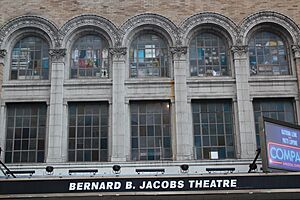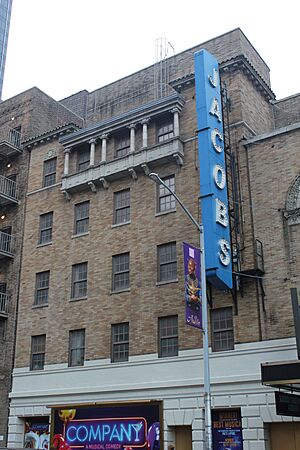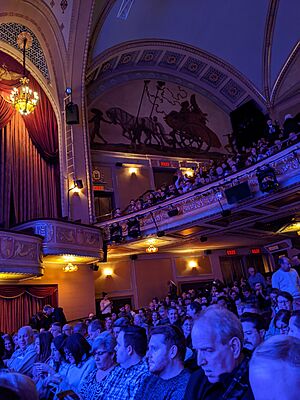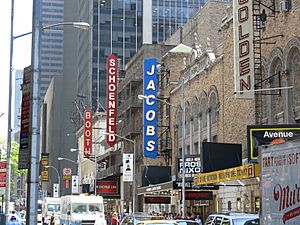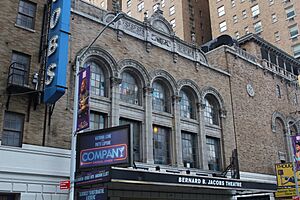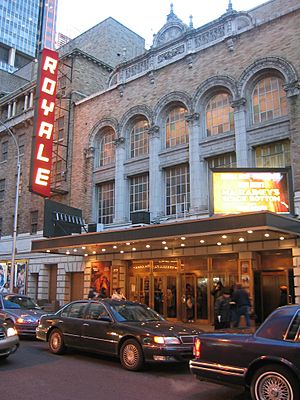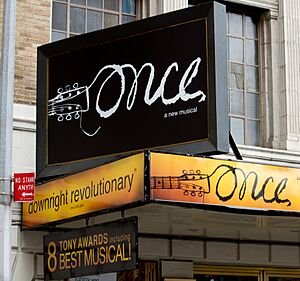Bernard B. Jacobs Theatre facts for kids
|
Royale Theatre
|
|

Showing The Ferryman, 2019
|
|
| Address | 242 West 45th Street (George Abbott Way) Manhattan, New York City United States |
|---|---|
| Coordinates | 40°45′31″N 73°59′16″W / 40.75861°N 73.98778°W |
| Public transit | Subway: Times Square–42nd Street/Port Authority Bus Terminal |
| Owner | Jacobs Theatre LLC |
| Operator | The Shubert Organization |
| Type | Broadway |
| Capacity | 1,092 |
| Production | The Outsiders |
| Construction | |
| Opened | January 11, 1927 |
| Architect | Herbert J. Krapp |
| Designated | December 15, 1987 |
| Reference no. | 1372 |
| Designated entity | Facade |
| Designated | December 15, 1987 |
| Reference no. | 1373 |
| Designated entity | Auditorium interior |
The Bernard B. Jacobs Theatre is a famous Broadway theater in New York City. It's located at 242 West 45th Street in the busy Theater District of Midtown Manhattan. The theater first opened its doors in 1927.
It was designed by Herbert J. Krapp in a beautiful Spanish style. The theater was built for a real estate developer named Irwin S. Chanin. It has about 1,100 seats for people to watch shows. Today, The Shubert Organization runs the theater. Both the outside (facade) and the inside (auditorium) are protected as important New York City landmarks. The theater was first called the Royale Theatre, and for a short time, it was known as the John Golden Theatre. It was renamed in 2005 to honor Bernard B. Jacobs, a longtime president of the Shubert Organization.
Contents
Where the Theater Is
The Bernard B. Jacobs Theatre is at 242 West 45th Street. This is on the south side of the street, between Eighth Avenue and Broadway. It's very close to Times Square in the Theater District of Midtown Manhattan, New York City.
This area is known for having the most Broadway theaters on one block. The street itself, 45th Street, is also called George Abbott Way. Lots of people walking on this street help theaters sell more tickets. The Jacobs Theatre is part of a group of buildings. These include the Majestic, Golden, and Royale (Jacobs) theaters, plus the Lincoln Hotel. All these buildings were built around the same time.
How the Theater Looks
The Bernard B. Jacobs Theatre, which was first called the Royale Theatre, was designed by Herbert J. Krapp. It was built between 1926 and 1927 for the Chanin brothers. This theater was part of a bigger entertainment complex. This complex also included the Lincoln Hotel and the Majestic and Masque theaters. All these buildings were designed by Krapp in a Spanish style. The Royale was planned to be the middle-sized theater in this group. It originally had about 1,200 seats. Today, The Shubert Organization operates the Jacobs Theatre.
Outside Look
The outside of the theater, called the facade, has two main parts. The part on the west side is wider. It is where the main entrance to the theater is located. The part on the east side is narrower and taller. This section holds the stage area.
At street level, the entrance has five sets of glass doors. These doors lead to the ticket office and the main seating area. There are also signs next to the doors. A large sign, called a marquee, hangs above the entrance. The stage door, where actors and crew enter, is shared with the Majestic and Golden theaters.
The upper parts of the building are made of gold-colored bricks. These bricks match the nearby theaters and hotel. The main entrance section has five large arches on the second and third floors. These arches have tall pillars with fancy tops. Each arch has iron-framed windows. A sign with the theater's name is placed between the two main sections of the building.
The stage section has windows on each floor from the second to the fifth. On the fifth floor, the middle three windows are part of a loggia. A loggia is like a small open-air hallway with columns. This loggia has a Spanish tile roof. There is also a pyramid-shaped tile roof above the stage area. The Jacobs Theatre's loggia looks similar to one on the Golden Theatre next door.
Inside Look
The inside of the Jacobs Theatre was first designed with colors like red, orange, and gold. One of the developers, Irwin Chanin, wanted to make the seating fair for everyone. So, the Jacobs was built with only one balcony, not two. Chanin felt that a second balcony was too far away from the stage. The Chanin brothers wanted each of their three theaters to look different but still have a Spanish theme. They believed that beautiful and comfortable theaters would attract more people.
The main designer for the inside was Roman Melzer. Willy Pogany painted murals, and Joseph Dujat created the plaster decorations. Today, the Jacobs Theatre has a red and gray color scheme.
The theater has a main floor (orchestra level), one balcony, special box seats, and a stage. The seating area is wider than it is deep. It has detailed plaster decorations that stick out from the walls. The Shubert Organization says there are 1,092 seats. Another group, The Broadway League, says there are 1,078 seats. The seats are divided into 636 on the orchestra level, 168 in the front of the balcony, 252 in the back of the balcony, and 16 in the box seats. There are also 20 spots for standing. Restrooms and drinking fountains are located below the orchestra level. The Jacobs Theatre is known for having great views of the stage from all seats.
Seating Areas
At the back of the orchestra level, there's a walkway with two columns that support the balcony above. The orchestra floor slopes down towards the stage. The walls in this area have textured blocks. There are doors on the side walls with exit signs above them. Two staircases lead from the orchestra level to the balcony. These stairs have metal railings with fancy designs. In front of the orchestra level is a pit for the orchestra, located below the stage. The orchestra level is accessible for wheelchairs, but there are no elevators to the balcony.
The balcony level is split into front and back sections by an aisle. The walls are made of textured blocks. Above the walls, there's a decorative band with flower-like designs. Lights and square panels with fancy patterns are on the underside of the balcony. The middle of the balcony's underside has a round decoration with a light and leaf designs. The outer parts of the underside have diamond-shaped panels with crisscross and fancy patterns. The front of the balcony has decorations of hanging fabric and flower designs. Air conditioning vents and lights have been added to the balcony's underside.
On each side of the stage, there's a curved wall section with two box seats. The front box is a bit lower than the back box. Each box has a railing with shield designs and mythical creatures. The underside of each box has a round decoration with a light and leaf designs. The curved ceilings above the boxes have Spanish-style brass chandeliers.
Other Cool Features
Next to the box seats is a curved archway that frames the stage. This is called the proscenium arch. It's surrounded by rope-like decorations and a wide band with leaf patterns. The proscenium arch is about 24 feet high and 40 feet wide. A curved panel, called a sounding board, extends from the arch onto the ceiling. This board helps direct the sound. It has a large decorative panel in the center with crisscross patterns. The rest of the sounding board was originally decorated with Spanish designs.
The ceiling of the theater is shaped like a curved vault. This vault extends over the balcony. It has decorative ribs with leaf and claw patterns. The center of the ceiling has a crisscross design where the ribs meet. There are also two large arches along the walls on either side of the vault. These arches feature beautiful murals by Willy Pogany, titled Lovers of Spain. Each mural shows a woman in a procession of musicians. These arches are surrounded by molded acanthus leaves and shell designs.
Theater History
The Times Square area became the main place for big theater shows between 1900 and the Great Depression. In the early 1900s, many theaters in Midtown Manhattan were built by the Shubert brothers. They were a major group in the theater world. The Chanin brothers, who usually worked in real estate, also built a group of theaters in the mid-1920s. Irwin Chanin, one of the brothers, became interested in theater when he was a student. He remembered feeling embarrassed having to use a separate door when he bought cheap seats in the upper balcony. By 1926, the Chanins decided to build and run theaters in New York and other big cities. Herbert Krapp had already designed other theaters for the Chanins before.
Building and Early Days
Chanin Brothers Run the Show
The Chanin brothers bought the land for the theater in May 1925. They planned to build a hotel and three theaters there. In March 1926, Krapp submitted plans for the hotel and theaters. The project was expected to cost $4.5 million. News reports said there would be a large theater, a medium-sized one, and a small one. The old houses on the site were torn down by June. In July, the Chanin brothers got a big loan for the four buildings. Irwin Chanin also held a contest for the public to suggest names for the three new theaters.
The names were announced in December 1926. The large theater became the Majestic. The medium-sized one became the Royale. The small one was named the Masque. The next month, the Chanins gave A. L. Erlanger control over booking shows for their new and existing theaters.
The Royale Theatre was the first of the three to open. It showed the play Piggy on January 11, 1927. The opening of these theaters helped Broadway expand further west. Each Chanin theater was meant for a different type of show. The 1,800-seat Majestic was for "revues and light operas." The 1,200-seat Royale was for "musical comedies." The 800-seat Masque was for "intimate" plays. By building different sized theaters at the same time, the Chanins saved money. A newspaper critic, Burns Mantle, wrote that the Royale had a "handsome auditorium" and a "well proportioned stage." Piggy didn't have a strong story, but the comedian Sam Bernard kept it going for 79 performances.
After Piggy, the Royale hosted Judy and then Oh, Ernest!. The Black revue Rang Tang also played there in 1927. Three Gilbert and Sullivan shows, The Mikado, Iolanthe, and The Pirates of Penzance, were also performed. In 1928, the Royale showed The Madcap and its first straight play, Sh! The Octopus. Later that year, the Royale had its first big hit, the Mae West play Diamond Lil. In 1929, the Shubert brothers bought the Chanin brothers' share in the Majestic, Masque, and Royale theaters for $1.8 million.
Great Depression and New Owners
The Shuberts took full control of the Royale in 1930. Under their management, the Royale hosted shows like Second Little Show and Lew Leslie's Blackbirds. Another Mae West play, Constant Sinner, was shown in 1931. Many other shows during this time were not successful. By then, the Shuberts were having financial problems. They had to give up the Royale, but they kept the Majestic and Masque.
In July 1932, producer John Golden got the right to rent the Royale for 21 months. This happened even though Lee Shubert objected. In November, Golden officially signed the lease. At this time, Golden had just lost the right to run his own theater on 58th Street.
The Royale hosted Golden's comedy When Ladies Meet in late 1932. The Theatre Guild then presented two plays: Both Your Houses (1933) and They Shall Not Die (1934). Most other shows at the Royale during this period were not successful. After the comedy Every Thursday, Golden renewed his lease in September 1934. He then renamed the Royale after himself. The first shows at the renamed theater included Small Miracle and Rain from Heaven. The Irish group Abbey Theatre Players started performing different shows every week in November 1934. This was followed by The Bishop Misbehaves and A Touch of Brimstone in 1935. In 1936, the Golden (Royale) hosted several short-lived shows.
The Broadway theater business struggled during the Great Depression. In November 1936, the Majestic, Masque, and Golden (Royale) theaters were sold to pay off a $2 million loan. A representative for the Shubert family bought the rights to run the theaters for $700,000. However, the Bankers Securities Corporation still owned half of them. John Golden, not giving up, moved his shows to the Masque and renamed that theater after himself. The Shuberts then rented the former Royale to CBS Radio the next month. CBS started using it as a radio studio in January 1937. The studio closed in May 1940 because there weren't enough shows to broadcast. The theater then went back to the Shuberts. In October 1940, the theater went back to its original name, the Royale.
Shubert Brothers Run the Show Again
1940s to 1970s
The Royale Theatre reopened on October 21, 1940, with the show Du Barry Was a Lady. The Royale then hosted several shows that moved from other theaters, like Flight to the West and The Corn Is Green in 1941. Some later shows were big hits, running for hundreds of performances. These included Counsellor-at-Law in 1942, and Ramshackle Inn and Catherine Was Great with Mae West in 1944. Less successful shows in 1945 included Good Night, Ladies and Strange Fruit. In 1945, the Shubert brothers bought the Majestic, John Golden (Masque), and Royale theaters from the Bankers Securities Corporation. This gave the Shubert family full ownership of these theaters.
Shows in 1946 included The Magnificent Yankee and The Glass Menagerie. Later, The Importance of Being Earnest and Medea were produced in 1947. The comedy Light Up the Sky ran for over 200 performances in 1948. The Madwoman of Chaillot played at the Royale the next year. The 1950s started with The Devil's Disciple and The Lady's Not for Burning in 1950. A show called Darkness at Noon moved there in 1951. After that, Borscht Capades and several short-lived shows played. The Royale then hosted New Faces of 1952. This was the last popular Broadway variety show for many years because TV became so popular.
The Immoralist played at the Royale in 1954. So did The Boy Friend, which was Julie Andrews's first Broadway show. The shortest show ever at the Royale also happened that year. The Starcross Story had only one performance. In 1955, the Royale featured The Matchmaker, which ran for 486 performances. Other popular shows in the 1950s were The Tunnel of Love in 1957 and The Entertainer in 1958. After showing the movie Gigi in May 1958, the Royale went back to live theater in November with La Plume de Ma Tante, which ran for over 800 performances.
In the early 1960s, the Royale hosted many shows. These included Becket in 1960, From the Second City in 1961, and The Night of the Iguana in 1961. The Karmon Israeli Dancers also performed for four weeks in May 1963. After that came The Rehearsal in 1963, and The Chinese Prime Minister and The Subject Was Roses in 1964. For most of the rest of the 1960s, the Royale was home to Cactus Flower. This show opened in 1965 and ran for 1,234 performances. Man in the Glass Booth, which opened in 1968, was the last major show of the 1960s. The Royale hosted Child's Play in 1970 and Moonchildren in 1972. From 1972 to 1980, the musical Grease played at the Royale. It became the longest-running show on Broadway at the time.
1980s and 1990s
In February 1980, Whose Life is it Anyway? opened at the Royale. Mary Tyler Moore played the main role, which had been written for a man. This was followed by A Day in Hollywood / A Night in the Ukraine, which ran for 588 performances. The Royale then hosted Duet for One with Anne Bancroft and Max von Sydow for a month. After that came Joseph and the Amazing Technicolor Dreamcoat, which also ran for over a year. Besides Broadway shows, the Royale also held college graduation ceremonies.
In the mid-1980s, the Royale had some short-running shows. These included The Human Comedy in 1984 and Home Front in 1985. The Royale then presented Song and Dance in 1985, which ran for 474 performances. This was followed by a short revival of the play Broadway in 1987. This was to celebrate George Abbott's 100th birthday. Other shows that didn't last long included Roza in 1987. The 1980s ended with two hits: Speed-the-Plow, which opened in 1988 and ran for 287 performances, and Lend Me a Tenor, which ran for over a year after opening in 1989. During the 1980s, the Shuberts fixed up the Royale as part of a plan to restore their Broadway theaters.
The New York City Landmarks Preservation Commission (LPC) started thinking about protecting the Royale as a landmark in 1982. They discussed it for several years. The LPC officially made the Royale's outside and inside a landmark in December 1987. This was part of a big effort in 1987 to make many Broadway theaters landmarks. The New York City Board of Estimate approved these decisions in March 1988. The Shuberts and other theater owners sued the LPC in June 1988. They wanted to stop the landmark designations for 22 theaters, including the Royale. They argued that the designations made it too hard to change the theaters. The lawsuit went all the way to the Supreme Court of the United States. But in 1992, the landmark designations were upheld.
The first hit at the Royale in the 1990s was the 1992 play Conversations with My Father, which ran for over a year. London's Royal National Theatre presented An Inspector Calls in 1994, which ran for 454 performances. The National Actors Theatre was the next to use the Royale, with a revival of Inherit the Wind. The Royal National Theatre also produced Skylight at the Royale in 1996. Triumph of Love premiered in 1997. The play Art opened in 1998 and ran through the next year with 600 performances. The Royale's last show of the 1990s was a revival of The Price in 1999.
2000s to Today
The Royale hosted a revival of the play Copenhagen in 2000, which ran for 326 performances. The theater then showed One Flew Over the Cuckoo's Nest and John Leguizamo's solo show Sexaholix in 2001. In 2002, The Elephant Man and Jackie Mason's comedy Prune Danish played there. In 2003, as part of an agreement with the United States Department of Justice, the Shuberts agreed to make their 16 landmarked Broadway theaters, including the Royale, more accessible for people with disabilities. Also in 2003, the Royale hosted the short-lived revivals Ma Rainey's Black Bottom and "Master Harold"...and the Boys, as well as the more successful Anna in the Tropics. The next year, A Raisin in the Sun and 'night, Mother played at the Royale.
In September 2004, the Shubert Organization decided to rename the Royale Theatre after its longtime president, Bernard B. Jacobs. They also renamed the nearby Plymouth Theatre after the current president, Gerald Schoenfeld. The two theaters were officially renamed in a ceremony on May 9, 2005. While Jacobs's family was very happy, some producers and theater fans found the renaming controversial. This was despite the long tradition of naming Broadway theaters after important people in theater. The play Glengarry Glen Ross opened just before the renaming and had 137 performances.
In 2006, the short-running drama Three Days of Rain and Martin Short's show Fame Becomes Me played there. The Jacobs also held a memorial for Lloyd Richards that year. Other shows in the late 2000s included Frost/Nixon and Rock 'n' Roll in 2007. The Country Girl and 13 played in 2008. God of Carnage was shown in 2009.
The Jacobs hosted Bloody Bloody Andrew Jackson in 2010. That Championship Season and The Mountaintop played in 2011. The musical Once opened at the Jacobs in 2012 and was a big hit, running for almost three years. Once was followed by the comedy It's Only a Play in 2015. The Jacobs hosted two musicals over the next two years: The Color Purple (2015) and Bandstand (2017). After that came the dramas The Iceman Cometh and The Ferryman in 2018, as well as Betrayal in 2019.
The theater closed on March 12, 2020, because of the COVID-19 pandemic. It reopened on November 15, 2021, with preview shows of Company, which ran until July 2022. After Company closed, the theater hosted Almost Famous from November 2022 to January 2023. New York City Center's production of Parade opened at the Jacobs in March 2023 and ran until August. In April 2024, the musical The Outsiders began playing there.
Famous Shows
Here are some of the well-known shows that have played at the Bernard B. Jacobs Theatre. They are listed by the year they first opened. This list only includes Broadway shows, not movies or taped performances.
Royale Theatre and John Golden Theatre
- 1927: Rang Tang
- 1927: The Mikado
- 1927: Iolanthe
- 1927: The Pirates of Penzance
- 1928: Diamond Lil
- 1930: Second Little Show
- 1930: Lew Leslie's Blackbirds
- 1931: Dracula
- 1931: Hamlet, Julius Caesar, The Merchant of Venice
- 1933: Both Your Houses
- 1934: Small Miracle
- 1936: Mulatto
- 1936: Star Spangled
- 1936: Ghosts
- 1940: Du Barry Was a Lady
- 1941: The Corn Is Green
- 1942: The Flowers of Virtue
- 1943: The World's Full of Girls
- 1944: Ramshackle Inn
- 1944: Catherine Was Great
- 1945: Strange Fruit
- 1946: The Glass Menagerie
- 1946: The Front Page
- 1947: The Importance of Being Earnest
- 1947: Love for Love
- 1947: Medea
- 1949: The Madwoman of Chaillot
- 1950: The Devil's Disciple
- 1950: Affairs of State
- 1950: The Lady's Not for Burning
- 1952: One Bright Day
- 1952: New Faces of 1952
- 1954: The Immoralist
- 1954: Sabrina Fair
- 1954: The Boy Friend
- 1955: The Matchmaker
- 1957: Miss Isobel
- 1958: The Entertainer
- 1958: La Plume de Ma Tante
- 1960: Becket
- 1961: The Night of the Iguana
- 1964: The Subject Was Roses
- 1964: A Severed Head
- 1964: Hughie
- 1965: All in Good Time
- 1965: And Things That Go Bump in the Night
- 1965: The Owl and the Pussycat
- 1965: Cactus Flower
- 1970: Child's Play
- 1971: How the Other Half Loves
- 1971: The Incomparable Max
- 1972: Moonchildren
- 1972: Jacques Brel is Alive and Well and Living in Paris
- 1972: Grease
- 1980: Whose Life is it Anyway?
- 1980: A Day in Hollywood / A Night in the Ukraine
- 1982: Joseph and the Amazing Technicolor Dreamcoat
- 1983: You Can't Take It with You
- 1984: The Human Comedy
- 1985: Pack of Lies
- 1985: Song and Dance
- 1987: Sweet Sue
- 1987: Broadway
- 1987: Roza
- 1988: Serious Money
- 1988: Speed-the-Plow
- 1989: Lend Me a Tenor
- 1992: Conversations with My Father
- 1993: The Kentucky Cycle
- 1994: An Inspector Calls
- 1996: Inherit the Wind
- 1996: Skylight
- 1997: Triumph of Love
- 1998: 'Art'
- 1999: The Price
- 2000: Copenhagen
- 2001: One Flew Over the Cuckoo's Nest
- 2002: The Elephant Man
- 2003: Ma Rainey's Black Bottom
- 2003: "Master Harold"...and the Boys
- 2003: Anna in the Tropics
- 2004: A Raisin in the Sun
- 2004: 'night, Mother
- 2005: Glengarry Glen Ross
Bernard B. Jacobs Theatre
- 2006: Three Days of Rain
- 2006: Martin Short: Fame Becomes Me
- 2007: Frost/Nixon
- 2007: Rock 'n' Roll
- 2008: The Country Girl
- 2008: 13
- 2009: God of Carnage
- 2010: Bloody Bloody Andrew Jackson
- 2011: That Championship Season
- 2011: The Mountaintop
- 2012: Once
- 2015: It's Only a Play
- 2015: The Color Purple
- 2017: Bandstand
- 2018: The Iceman Cometh
- 2018: The Ferryman
- 2019: Betrayal
- 2021: Company
- 2022: Almost Famous
- 2023: Parade
- 2024: The Outsiders
Ticket Sales Records
The musical Once used to hold the record for the most money earned at the Bernard B. Jacobs Theatre. It made $1,447,598 over nine performances in the week ending December 30, 2012. This record was broken by Parade, which earned $1,814,013 in the week ending August 6, 2023.
See also
 In Spanish: Teatro Bernard B. Jacobs para niños
In Spanish: Teatro Bernard B. Jacobs para niños
- List of Broadway theatres
- List of New York City Designated Landmarks in Manhattan from 14th to 59th Streets


